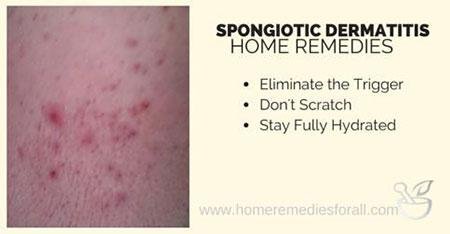Spongiotic dermatitis is a chronic skin condition that usually affects the skin on and around the abdominal, chest areas and buttocks. It doesn't generally appear on other parts of the body, though there may be some exceptions. Most other dermatitis affect scalp, face and limbs!
In that respect Spongiotic Dermatitis is easy to diagnose based on the affected body areas. It is also commonly known as Acute Eczema.
It is easy to treat it as well. Once you know, through proper diagnosis that it is Spongiotic Dermatitis, then you can use many simple home remedies to get rid of it fairly quickly.
This is a typical male skin condition. More than 75% cases of Spongiotic Dermatitis are reported to be men. The disease is contracted early in life at a young age. In babies it can get confused with diaper rash. Spongiotic Dermatitis occurs as a result of some allergic reaction. It may be an allergy to food, insect bite or overreaction of certain drug or medication.
It can be acute or subacute in its impacts. Spongiotic The main difference between acute and subacute spongiotic dermatitis is in the size of the vesicles developed by intercellular edema. The acute spongiotic dermatitis has larger vesicles compared to the subacute spongiotic dermatitis.
Like every other type of dermatitis the first sign comes as itch. After severe bouts of itching generally rash appears. The rash is usually red in the beginning which turns brown after repeated scratching of the affected skin areas in stomach, chest and buttocks where it usually occurs.
If left untreated the skin rash may turn black in color due to regular scratching over a prolonged period. Due to excessive itching it may leave permanent scar on the body.
Natural Remedies to Get Rid of Spongiotic Dermatitis
Once a proper diagnosis is done to confirm that you have Spongiotic Dermatitis, then the next step is to identify the cause that leads to the outbreak. Identifying the triggers of Spongiotic Dermatitis is a challenging process of elimination of the substances that can cause it. It varies from individual to individual.
Step1. Eliminate the Trigger
Knowing the trigger and avoiding it, can instantly reduce the size of the problem.
- Changes in food habits helps particularly if certain food items are found to trigger the outbreak. Food items such as eggs, milk, soy, wheat and fish can cause Spongiotic Dermatitis in some individuals.
- Stop taking hot water shower. This is one factor that works well in most skin conditions and particularly in the case of Spongiotic Dermatitis. Hot water cause dry skin which can increase urge to itch.
- Avoid direct exposure of all sorts of soaps on your body. The chemicals used in the soaps and detergents can cause allergies. Change detergent to wash your clothes. Certain chemicals in a particular brand may be causing the allergy.
- Woolen clothes and certain synthetic material cause allergic reactions to the skin. if you have Spongiotic Dermatitis, then avoid wearing those clothes
- Tobacco and pollution can trigger Spongiotic Dermatitis. Avoid exposure.
Step2. Don't Scratch
This is so much common sense to not scratch, yet subconsciously, when you feel the itch, you will get the urge to scratch. Control is the key here. Avoid scratching at all cost. You will thank yourself soon. Scratching extends the affected area and you end up worsening the condition.
- Don't scratch
- Use moisturizer to reduce the urge to scratch
- Apply calamine lotion or mild menthol containing skin moisturizing creams
- Cover your skin with cool cloths. Exposed skin will increase the urge to itch
Step3. Hydrate Yourself
Dehydration cause dry skin. In fact you already have dry skin that is why you have Spongiotic Dermatitis. Drink a lot of water and other fruits and vegetable juices. Carbonated drinks will increase dehydration so avoid them.
In fact, dehydration is one of the biggest causes of so many skin conditions including fast aging. So maintaining a well hydrated body is essential to maintain good skin and overall health conditions.
If you follow all the above 3 steps diligently, then your Spongiotic Dermatitis will disappear within a week or two. However if the skin conditions still remains unchanged or worsens then get medical help. It may be some other problem then Spongiotic Dermatitis.

